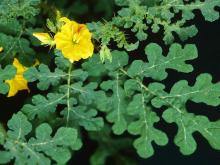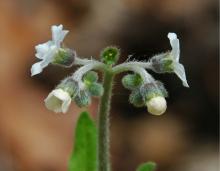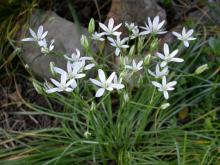Wildflowers, Grasses and Other Nonwoody Plants
Media

Species Types
Scientific Name
Saponaria officinalis
Description
Soapwort is a tall, showy wildflower that has chemicals in its sap that lather up like soap. Native to Eurasia, it has been introduced worldwide and is a common roadside wildflower.
Media

Species Types
Scientific Name
Phytolacca americana
Description
A tall, smooth, branching plant with red stems and juicy, dark purple berries, pokeweed is both toxic and a traditional edible potherb called poke salat. It is common statewide.
Media

Species Types
Scientific Name
Solanum rostratum
Description
A spiny annual with bright yellow flowers and dandelion-like leaves, buffalo bur is an introduced member of the nightshade family.
Media

Species Types
Scientific Name
Datura stramonium
Description
Pretty but poisonous, jimsonweed has white goblet-shaped flowers that open around midnight. This native of tropical America was introduced nearly throughout the United States and thrives in disturbed soils.
Media

Species Types
Scientific Name
Solanum carolinense
Description
Horse nettle is a native perennial with spiny stems and leaves, white to purplish flowers, and toxic fruits that look like tiny yellow tomatoes. It does well in disturbed habitats, and many people consider it a weed.
Media

Species Types
Scientific Name
Aquilegia canadensis
Description
Native to much of eastern North America, eastern red columbine's range almost matches the breeding territory of the ruby-throated hummingbird, its number-one pollinator. Its bloom time matches the hummingbird's northward migration, too.
Media

Species Types
Scientific Name
Cynoglossum virginianum
Description
Wild comfrey has large basal leaves that are soft, hairy, and elliptical with long petioles — they look like hounds’ tongues! The upright flowering stalk has few leaves and looks like a wand.
Media

Species Types
Scientific Name
Ornithogalum umbellatum
Description
Star of Bethlehem is an introduced exotic plant that makes clusters of bright white flowers in the spring. It reproduces prolifically by forming a multitude of bulbs underground.
Media

Species Types
Scientific Name
Mirabilis nyctaginea
Description
Wild four-o’clock grows in fields, prairies, waste places, roadways, and railroads, often in poor soils. It’s called “four-o’clock,” because the magenta flowers don’t open until late afternoon.
Media

Species Types
Scientific Name
Euphorbia corollata
Description
With widespread sprays of small white flowers, flowering spurge looks a lot like the "baby's breath" so popular with florists. Each little "flower" has 5 white false petals surrounding a cup of tiny yellow male flowers and a single female flower.
See Also
About Wildflowers, Grasses and Other Nonwoody Plants in Missouri
A very simple way of thinking about the green world is to divide the vascular plants into two groups: woody and nonwoody (or herbaceous). But this is an artificial division; many plant families include some species that are woody and some that are not. The diversity of nonwoody vascular plants is staggering! Think of all the ferns, grasses, sedges, lilies, peas, sunflowers, nightshades, milkweeds, mustards, mints, and mallows — weeds and wildflowers — and many more!





















